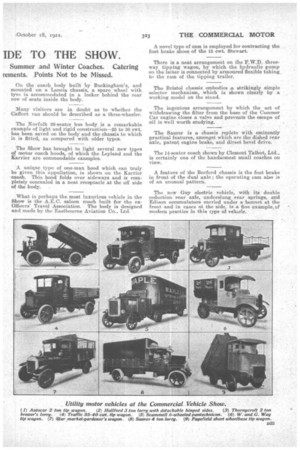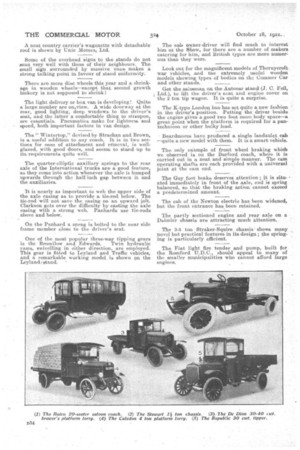THE BUSINESS MA? IDE TO THE SHOW.
Page 28

Page 29

Page 30

If you've noticed an error in this article please click here to report it so we can fix it.
Features to Look for : Luxurious Passeno for Municipal and Industrial Tran Summer and Winter Coaches. Catering rements. ,Points Not to be Missed.
TO the business man, an attractive feature on many of the stands will be the label "substantial reductions in price.' Some remarkable cuts. are announced, the bearing which they will have upon overhead charges being highly important.
ox The Thomas four-speed gearbox on the Commer successful Car is a fine example of the application of dog clutches for gear changing. '
The F.W.D.polished chassis forms one of the most interesting exhibits, and from it the visitor can ob'tain a very good idea of the four-wheel-drive principle, as applied to this vehicle. Attention should be paid to the firebox on the Yorkshire wagon ; this is now pressed complete out of a in. steel plate. A neat rotary tyre pump, driven by a friction wheel from the flywheel, is incorporated in one of the A.E.C. vehicles.
The successful application of railway coach design to a motor coach body is clearly seen in one of the ,handsome Chelsea bodies.
Two new trailers of particular interest are shown on the Bartle and Sentinel stands.
A noveltype of tipping gear in which rotating levers are employed is shown on the Autocar chassis.
The practicability of the Baico passenger vehicles is causing many prosnective users furiously to think. Tothose visitors who are not thoroughly cognizant with engine construction the Beardmore sectioned engine is giving useful information.
Thereare two points of especial interest in the Caledon exhibits one is the Burt-MoCollum singlesleeve-valve engine and the other the new and simple selector gear on the seven-tonner.
Two giants of the Show are m e the 27 ft. Scmell The Two giants of the Show are m e the 27 ft. Scmell The latter and the overtype Maudslay. e latter carries a three ton small brother on its back.
, The American light van forces are well represented in Dodge, Dort, Chevrolet, Overland—and Ford.
In the A.E.C. tipper the plunger pump for the hydraulic ram has been replaced by an Albany gear pump.
Twelve drop ,windows in a single-deck bus is the feature of one of Strachan and Brown's bodies.
The extent to which the giant pneumatic has progressed is to be seen in the number of buses and coaches fitted with this equipment. On the coach body built by Buckingham's, and mounted on a Lancia chassis, a spare wheel with tyre is accommodated in a locker behind the rear row of seats inside the body.
Many visitors are in doubt as to whether the Caffort van should be described as a three-wheeler.
The Norfolk 26-seater bus body is a remarkable exaraple of light and rigid construction-25 to 30 cwt. has been saved on the body and the chassis to which it is fitted, as compared with older types.
The Show has brought to light several new types of motor coach hoods, of which the Leyland and the Karrier are commendable examples.
A unique typo of one-man hood which can truly be given this appellation, is shown on the Karrier -coach. This hood folds over sideways and is completely concealed in a neat receptacle at the off side of the body.
What is perhaps the most luxurious vehicle in the Show is the A.E.C. saloon coach built for the exOfficers' Travel Association. The body is designed and made by the Eastbourne Aviation Co., Ltd. A novel type of cam is employed for contracting the foot brake shoes of the 15 cwt. Stewart.
There is a neat arrangement on the F.W.D. threeway tipping wagon, by which the hydraulic pump on the latter is connected by armoured flexible tubing to the ram of the tipping trailer.
The Bristol chassis embodies a strikingly simple selector mechanism, which is shown clearly by a working model on the stand.
The ingenious arrangement by which the act of withdrawing the filter from the base of the Commer Car engine closes a valve and prevents the escape of oil is well worth -studying.
The Saurer is a chassis replete with eminently practical features, amongst which are the dished rear axle, patent engine brake, and direct bevel drive.
The 14-seater coach shown by Clement Talbot, Ltd., is certainly one of the handsomest small coaches on view.
A feature of the Burford chassis is the foot brake in front of the thial axle ; the operating cam 'also ;s of an unusual pattern.
The new Guy electric vehicle, with its double reduction rear axle, underslung rear springs, and Edison accumulators carried under a bonnet at the front. and in cases at the side, is a fine example, of modern practice in this type O-1. vehicle. A neat country carrier's wagonette with detachable roof is shown by Unic Motors, Ltd.
Some of the overhead signs to the stands do not wan very well with those of their neighbours. The small sign surrounded by massive one& makes a strong talking point in favour of stand uniformity.
There are more disc wheels this year and a shrinkage in wooden wheels—excerpt that second growth hickory is not supposed to shrink I The light delivery or box van is developing ! Quite a large number are on,view. A wide doorway at the rear, good lighting, deep windows to the driver's seat, and the latter a comfortable thing to sitsupon, are essentials. Pneumatics make for lightness and speed, both important factors in van design.
The" Wintertop," devised by Strachan and Brown, is a. useful addition to any coach. It is in. two sec-, tions for ease of attachment and rilmoval, is wellglazed, with good doors, and seems to stand up to its requirements quite well.
The quarter-elliptic auxiliary springs to the rear axle of the International trucks are a good feature, as they come into action whenever the axle is bumped upwards through the half-inch gap between it and the auxiliaries.
It is nearly as important to web the upper side of the axle easing as to provide a tie-rod below. The tie-rod will not save the casing on an. upward jolt. Clarkson gets over the difficulty by casting the axle easing with a strong web. Panhards use tie-rods above and below.
On the Panharcl a sprag is bolted to the near side frame member close to the driver's seat.
One of the most popular three-way tipping gears is the Bromilow and Edwards. Twin hydraulic rams, swivelling in either direction, are employed. This gear is fitted to Leyland and Traffic vehicles, and a remarkable working model is shown pn the Leyland stand. • The cab owner-driver will find much to interest him at the Show, for there are a number of makers catering for him, and British types are more numerous than they were.
Look out for the magnificent models of Thornycroft war vehicles, and the extremely useful wooden models showing types of bodies on the Commer Car and other stands.
Get the salesman on. the Autocar stand (J. (J. Fell, Ltd.), to lift the driver's seat and engine cover on the 2 ton tip wagon. It is quite a surprise.
The K-typo London bus has set quite a, new fashion in the driver's position. Putting the driver beside the engine gives a good two foot more body space—a great point when. the platform is required for a pantechnicon or other bulky load.
Beardmores have produced a single landaulet cab —quite a new model with them. It is a smart vehicle.
The only example of front wheel braking which we observed is on the Burford coach, where it is carried out in a neat and simple manner. The cam operating shafts are each provided with a universal joint at the cam end.
The Guy foot brake deserves attention ; it is situated immediately in front of the a,xle, and is spring balanced, so that the braking action cannot exceed a predetermined amount.
The cab of the Newton electric has been widened, but the front entrance has been retained.
The partly sectioned engine and rear axle on a Daimler chassis are attracting much attention.
The 3-5 ton Straker-Squire chassis shows many novel but practical features in its design; the springing is particularly efficient.
The Fiat light fire tender and pump, built for the Bamford U.D.C., should appeal to many of the smaller municipalities who cannot afford large engines.
































































